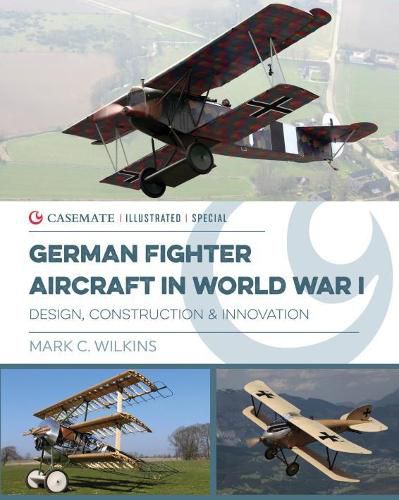Readings Newsletter
Become a Readings Member to make your shopping experience even easier.
Sign in or sign up for free!
You’re not far away from qualifying for FREE standard shipping within Australia
You’ve qualified for FREE standard shipping within Australia
The cart is loading…






Fully illustrated overview of the development and different types of German Fighter aircraft during World War I. Fighter aircraft were developed by during World War I at an unprecedented rate, as nascent air forces sought to achieve and maintain air supremacy. German manufacturers innovated at top speed, while constantly scrutinising the development of new enemy aircraft. The Germans also utilised the concept of systematic production or modular engineering during the war - Fokker capitalised on this aspect with all his aircraft built in a similar fashion - wooden wings with welded steel fuselages. This meant that they could be disassembled or reassembled quickly in the field - unlike many Allied aircraft. Pfalz and Albatros were the first to realise the importance of a streamlined fuselage - the precursor to all that would follow. Both of these companies built semi-monocoque fuselages using plywood to develop semi-stressed skin - the Allies had nothing like this. The Germans also perfect powerful inline engines, as exemplified by the Albatros fighters. These engines did not have the gyroscopic effect of the rotary engines and as such were easier and more stable to fly. Fokker was slow to give up his rotary engines but once he did, the result was the iconic Fokker D VII - years ahead of its time and the only aircraft specifically mentioned in the Treaty of Versailles that Germany could not build after the war. German Fighter Aircraft in World War I explores how German fighter aircraft were developed during the war, the innovations and trials that made the Fokker D VII possible, and the different makes and types of aircraft. Using unpublished images including photographs of surviving aircraft, archive images, and models and replicas, it shows details of aircraft that were kept top secret during the war. Extensively illustrated with 140 photos and ten colour profiles, this is will be essential reading for all WWI aviation enthusiasts and modellers. AUTHOR: Mark Wilkins is an historian, writer, museum professional, and professional modelmaker. He has been director & curator of the Cape Cod Maritime Museum and The Atwood House Museum (Chatham Historical Society), and has worked for the Smithsonian & Mystic Seaport. He writes and lectures on maritime and aviation history, and is a contributing author to magazines including Model Aviation, Model Airplane News, Fly RC, RC Model World, RCM &E, Smithsonian’s Air & Space Magazine, and Aviation History, with a focus on WWI aircraft.
400 photographs and diagrams and 10 colour profiles
$9.00 standard shipping within Australia
FREE standard shipping within Australia for orders over $100.00
Express & International shipping calculated at checkout
Fully illustrated overview of the development and different types of German Fighter aircraft during World War I. Fighter aircraft were developed by during World War I at an unprecedented rate, as nascent air forces sought to achieve and maintain air supremacy. German manufacturers innovated at top speed, while constantly scrutinising the development of new enemy aircraft. The Germans also utilised the concept of systematic production or modular engineering during the war - Fokker capitalised on this aspect with all his aircraft built in a similar fashion - wooden wings with welded steel fuselages. This meant that they could be disassembled or reassembled quickly in the field - unlike many Allied aircraft. Pfalz and Albatros were the first to realise the importance of a streamlined fuselage - the precursor to all that would follow. Both of these companies built semi-monocoque fuselages using plywood to develop semi-stressed skin - the Allies had nothing like this. The Germans also perfect powerful inline engines, as exemplified by the Albatros fighters. These engines did not have the gyroscopic effect of the rotary engines and as such were easier and more stable to fly. Fokker was slow to give up his rotary engines but once he did, the result was the iconic Fokker D VII - years ahead of its time and the only aircraft specifically mentioned in the Treaty of Versailles that Germany could not build after the war. German Fighter Aircraft in World War I explores how German fighter aircraft were developed during the war, the innovations and trials that made the Fokker D VII possible, and the different makes and types of aircraft. Using unpublished images including photographs of surviving aircraft, archive images, and models and replicas, it shows details of aircraft that were kept top secret during the war. Extensively illustrated with 140 photos and ten colour profiles, this is will be essential reading for all WWI aviation enthusiasts and modellers. AUTHOR: Mark Wilkins is an historian, writer, museum professional, and professional modelmaker. He has been director & curator of the Cape Cod Maritime Museum and The Atwood House Museum (Chatham Historical Society), and has worked for the Smithsonian & Mystic Seaport. He writes and lectures on maritime and aviation history, and is a contributing author to magazines including Model Aviation, Model Airplane News, Fly RC, RC Model World, RCM &E, Smithsonian’s Air & Space Magazine, and Aviation History, with a focus on WWI aircraft.
400 photographs and diagrams and 10 colour profiles